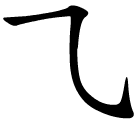Regardless of their impressive number and variety, all Chinese characters are composed of less than 30* so-called "strokes". These can be compared to the letters used in English script: They are the smallest components of a word (respectively a character) and cannot be broken up any further.
The following table lists all strokes that occur in Chinese characters.
| # | Stroke (variants) | Name (in Mandarin Chinese) |
Example character | |
Basic strokes (without changes of direction) |
||||
| 1 | 点, diǎn | |||
| 2 | 横, héng | |||
| 3 | 竖, shù | |||
| 4 |  |
撇, piě | ||
| 5 |  |
捺, nà | ||
| 6 | 提,tí | |||
Complex strokes |
||||
| 钩 gōu | ||||
| 7 |  |
横折钩, héng zhé gōu also: 横折, héng zhé |
||
| 8 |  |
 |
横折弯钩, héng zhé wān gōu | |
| 9 | 横钩, héng gōu | |||
| 10 | 竖钩, shù gōu | |||
| 11 |  |
竖弯钩, shù wān gōu | ||
| 12 |  |
斜钩, xié gōu | ||
| 13 |  |
平钩, píng gōu | ||
| 14 |  |
竖折折钩, shù zhé zhé gōu | ||
| 点 diǎn | ||||
| 15 |  |
撇点, piě diǎn | ||
| 16 |  |
撇折, piě zhé | ||
| 17 | 竖折, shù zhé | |||
| 18 | 横撇, héng piě | |||
| 19 | 横折折撇, héng zhé zhé piě | |||
Missing a stroke? Let us know! |
||||
*Some strokes occur in different variants that can also be regarded as separate strokes. This is why there is no official number of strokes.
Question: "Do traditional Chinese characters contain other strokes than the modern, simplified characters?"
Answer:
No, both types of characters are using the same strokes from the above table as basic components.
Question: "Which font is used for the Chinese characters in the table above?"
Answer:
The strokes and characters were created using the KaiTi (楷体) font with a font size of 150pt. This font is based on handwriting: the strength of the stokes and lines varies as if a pincel had been used to write them.
Question: "Which font is used for the Chinese characters in the Han Trainer Online Dictionary?"
Answer:
If you are using the (normal) Han Trainer Chinese-English dictionary, the characters are displayed in the font "SimSun". This font uses serifs. It has been designed for printing purposes and can be read easily on screens and on paper. It's the most commonly used font for Chinese texts. However, it's not the kind of font you would use if the result should look nice and natural.
All other dictionaries use the font "KaiTi".
Question: "Are you sure about the average of 13 strokes in a Chinese character?"
Answer:
I know it seems a bit much. And in fact, most simplified characters you'll encounter will have less than 13 strokes.
How does this go together? The answer is frequency-weighted average:
It means that the more common characters have a lower number of strokes.
According to Chih-Hao Tsai, ...
and so on...
All content is protected under German and international copyright laws. imprint & contact information | privacy policy